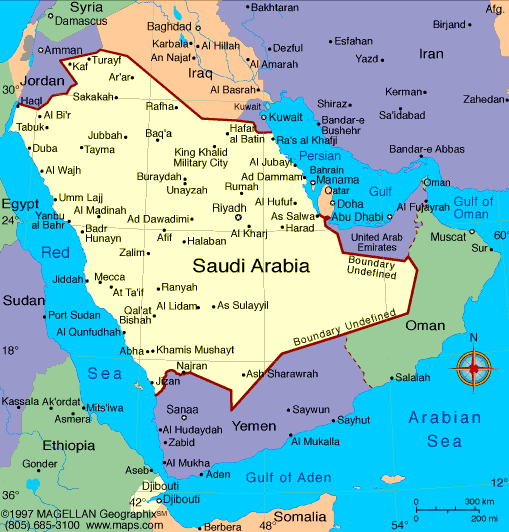SAUDI ARABIA

Geography: Saudi Arabia occupies most of the Arabian Peninsula, with the Red Sea and the Gulf of Aqaba to the west and the Persian Gulf to the east. Neighboring countries are Jordan, Iraq, Kuwait, Qatar, the United Arab Emirates, the Sultanate of Oman, Yemen, and Bahrain, connected to the Saudi mainland by a causeway. Saudi Arabia contains the world's largest continuous sand desert, the Rub Al-Khali, or Empty Quarter. Its oil region lies primarily in the eastern province along the Persian Gulf.
Government: Saudi Arabia was an absolute monarchy until 1992, at which time the Saud royal family introduced the country's first constitution. The legal system is based on the sharia (Islamic law).
History: Saudi Arabia is not only the homeland of the Arab peoples—it is thought that the first Arabs originated on the Arabian Peninsula—but also the homeland of Islam, the world's second-largest religion. Muhammad founded Islam there, and it is the location of the two holy pilgrimage cities of Mecca and Medina. The Islamic calendar begins in 622, the year of the hegira, or Muhammad's flight from Mecca. A succession of invaders attempted to control the peninsula, but by 1517 the Ottoman Empire dominated, and in the middle of the 18th century, it was divided into separate principalities. In 1745 Muhammad ibn 'Abd al-Wahhab began calling for the purification and reform of Islam, and the Wahhabi movement swept across Arabia. By 1811, Wahhabi leaders had waged a jihad—a holy war—against other forms of Islam on the peninsula and succeeded in uniting much of it. By 1818, however, the Wahhabis had been driven out of power again by the Ottomans and their Egyptian allies.
The kingdom of Saudi Arabia is almost entirely the creation of King Ibn Saud (1882–1953). A descendant of Wahhabi leaders, he seized Riyadh in 1901 and set himself up as leader of the Arab nationalist movement. By 1906 he had established Wahhabi dominance in Nejd and conquered Hejaz in 1924–1925. The Hejaz and Nejd regions were merged to form the kingdom of Saudi Arabia in 1932, which was an absolute monarchy ruled by sharia. A year later the region of Asir was incorporated into the kingdom.

Map of Saudi
Arabia
Sovereign: King Salman (2015)
Land area: 829,995 sq mi (2,149,690 sq
km)
Population (2014 est.): 27,345,986
(growth rate: 1.49%); birth rate: 18.78/1000; infant mortality rate:
14.58/1000; life expectancy: 74.82; density per sq mi: 31
Capital and largest city (2011 est.):
Riyadh, 5.451 million
Other large cities: Jeddah, 3.578 millioin;
Makkah (Mecca), 1.591 million
Monetary unit: Riyal
National
name: Al-Mamlaka al-'Arabiya as-Sa'udiya
Language:
Arabic
Ethnicity/race:
Arab 90%, Afro-Asian 10%
Religion:
Muslim (official; citizens are 85-90% Sunni and 10-15%
Shia), other (includes Eastern Orthodox, Protestant, Roman Catholic,
Jewish, Hindu, Buddhist, and Sikh) (2012 est.)
Literacy rate: 87.2% (2011 est.)
Economic summary: GDP/PPP (2013 est.):
$927.8 billion; per capita $31,300. Real growth rate: 3.6%.
Inflation: 3.7%. Unemployment: 10.5% male only (local bank
estimate; some estimates range as high as 25%) (2013 est.). Arable
land: 1.45%. Agriculture: wheat, barley, tomatoes, melons,
dates, citrus; mutton, chickens, eggs, milk. Labor force: 8.412
million; note: about 80% of the labor force is non-national (2013); agriculture 6.7%, industry 21.4%, services 71.9%
(2005 est.). Industries: crude oil production, petroleum
refining, basic petrochemicals; ammonia, industrial gases, sodium
hydroxide (caustic soda), cement, fertilizer, plastics; metals,
commercial ship repair, commercial aircraft repair, construction.
Natural resources: petroleum, natural gas, iron ore, gold,
copper. Exports: $376.3 billion (2013 est.): petroleum and
petroleum products 90%. Imports: $147 billion (2013
est.): machinery and equipment, foodstuffs, chemicals, motor vehicles,
textiles. Major trading partners: U.S., Japan, South Korea,
China, Singapore, Germany, India (2012).
Communications: Telephones: main lines in
use: 4.8 million (2012 est.); mobile cellular: 53 million (2012
est.). Radio broadcast stations: AM 43, FM 31, shortwave 2
(1998). Radios: 6.25 million (1997). Television broadcast
stations: 117 (2007). Televisions: 5.1 million (1997).
Internet Service Providers (ISPs): 145,941 (2012). Internet
users: 9.774 million (2009).
Transportation: Railways: total: 1,378 km
(2008). Highways: total: 221,372 km; paved: 47,529 km; unpaved:
173,843 km (2006). Ports and harbors: Ad Dammam, Al Jubayl, Jeddah, Yanbu al Bahr. Airports: 214
(2013).
International disputes:Saudi
Arabia has reinforced its concrete-filled security barrier along
sections of the now fully demarcated border with Yemen to stem illegal
cross-border activities; Kuwait and Saudi Arabia continue discussions on
a maritime boundary with Iran; Saudi Arabia claims
Egyptian-administered islands of Tiran and Sanafir.
-------------------- o --------------------
No comments:
Post a Comment